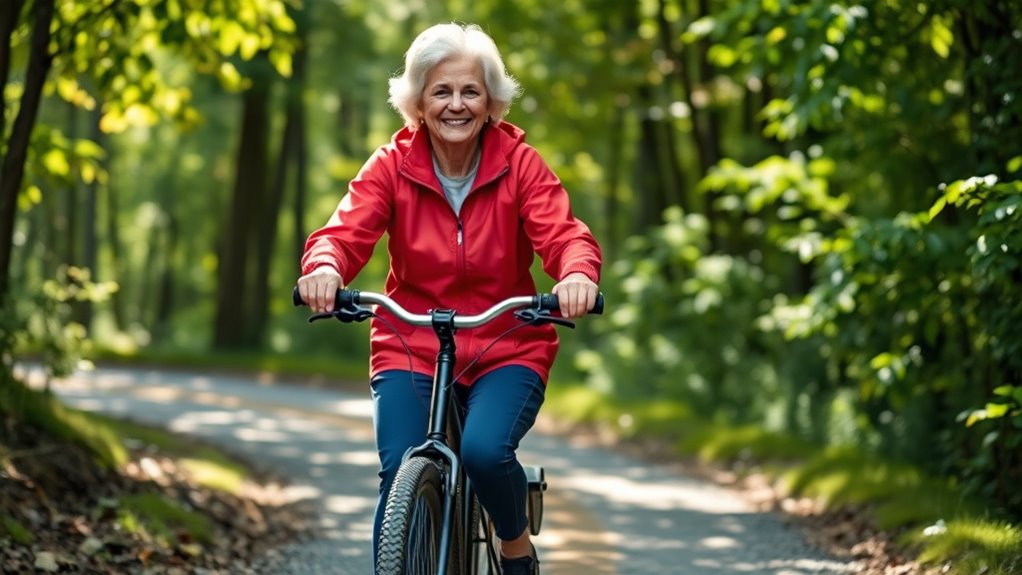Starting to cycle later in life is absolutely possible, and your mindset makes all the difference. With patience, a positive attitude, and the right equipment, you can learn at your own pace. Practice in flat, open spaces and focus on balancing and pedaling. Celebrate small wins to stay motivated and gradually challenge yourself more. Remember, it’s never too late to enjoy the freedom, health benefits, and fun that cycling brings—there’s more to discover along the way.
Key Takeaways
- A positive mindset and patience are essential for learning to cycle at any age.
- Use a comfortable, well-fitting bike and practice in flat, open spaces for safety.
- Focus on balancing and pedaling gradually, accepting initial awkwardness as normal.
- Celebrate small successes and progressively challenge yourself to build confidence.
- Cycling offers physical, mental, and social benefits, making it rewarding regardless of age.

Many people believe that learning to cycle is something best left to childhood, but it’s never too late to start. No matter your age, you can learn to ride a bike and enjoy the many benefits it offers. The first step is to approach it with patience and a positive attitude. Your body might feel different than it did when you were younger, but that doesn’t mean you can’t master cycling now. You’ll find that with the right mindset, your confidence will grow quickly.
It’s never too late to learn to ride and enjoy cycling’s many benefits at any age.
Begin by choosing a comfortable, well-fitting bike suited to your size and riding style. You don’t need a fancy racing bike; a simple, sturdy one will do. If you’re unsure about your balance or coordination, consider starting in a safe, flat, open space like a park or empty parking lot. It’s best to find a level surface where you can focus solely on learning without worrying about traffic or obstacles. Wearing a helmet and protective gear is essential to keep you safe as you learn.
Start by familiarizing yourself with the bike: sit on it, get a feel for how it balances, and practice pushing off with your feet. You might find it helpful to hold onto a sturdy object, like a railing or wall, as you practice gliding and balancing. Don’t rush the process; it’s normal to feel awkward at first. Your goal is to get comfortable with the sensation of balancing and pedaling, not to immediately master perfect technique. As you gain confidence, start practicing short rides with someone who can support you or be nearby in case you need help. Incorporating proper cycling techniques can also help you develop good habits from the start and make your riding experience more enjoyable. Additionally, focusing on balance and coordination can significantly improve your ability to ride confidently.
Learning to cycle later in life can be a rewarding experience, and it’s important to celebrate small victories along the way. As your balance and confidence improve, gradually challenge yourself with slightly longer rides or more complex terrains. Remember, it’s not about speed or distance at first; it’s about building your skills gradually and enjoying the process. You might experience some initial discomfort or frustration, but persistence is key. The more you practice, the more natural it will feel.
Many find that cycling becomes a fun, liberating activity that boosts their physical health and mental well-being. It’s a wonderful way to explore your surroundings, meet new people, and stay active. Incorporating proper safety gear not only helps prevent injuries but also boosts your confidence while riding. Additionally, learning proper cycling techniques can make your rides safer and more enjoyable. No matter your age or previous experience, you are capable of learning to ride. With patience, perseverance, and a positive attitude, you’ll soon find yourself enjoying the simple pleasure of cycling and reaping its many rewards. Remember, it’s never too late to ride and discover new adventures on two wheels.
Frequently Asked Questions
What Safety Gear Is Recommended for Older Beginner Cyclists?
When you begin cycling, especially as an older beginner, safety gear is essential. You should wear a well-fitting helmet to protect your head, reflective clothing or accessories to increase visibility, and gloves for grip and comfort. Consider knee and elbow pads if you’re concerned about falls. Always carry a bell or horn to alert others, and use lights if you ride in low-light conditions. Safety gear helps keep you confident and protected on every ride.
How Can I Find Beginner-Friendly Cycling Routes Nearby?
To find beginner-friendly cycling routes nearby, start by checking local parks, bike trails, or community centers’ websites. Use cycling apps or maps like Strava, Komoot, or Google Maps to discover flat, low-traffic paths ideal for beginners. Ask fellow cyclists or join local cycling groups for recommendations. These options help you find safe, enjoyable routes that match your skill level, making your riding experience comfortable and fun.
Are Special Bikes Needed for Seniors Starting to Cycle?
Think of your bike as a trusted companion on your journey. You don’t need special bikes to start; a comfortable, easy-to-handle bike will do. Look for features like a low step-through frame, wider seats, and smooth gears. These symbolize your readiness to embrace new adventures. As you pedal forward, trust that your trusty bike will support every twist and turn on your path to cycling joy.
How Long Does It Typically Take to Become Comfortable Cycling?
It usually takes a few days to a few weeks for you to become comfortable cycling, depending on your experience and confidence. Practice consistently, start on flat, smooth surfaces, and gradually introduce more challenging terrain. Don’t rush; focus on balancing and steering first. With patience and regular riding, you’ll find yourself gaining confidence quickly, and cycling will become a fun, enjoyable part of your routine.
Can Cycling Help Improve Balance and Prevent Falls?
Like a steady drumbeat, cycling can markedly improve your balance and help prevent falls. When you pedal regularly, your core and leg muscles strengthen, giving you better stability. Plus, the focus required on the bike sharpens your coordination. As you gain confidence, you’ll find it easier to navigate uneven surfaces and maintain your footing in daily life, making cycling a fun, effective way to stay steady and safe.
Conclusion
So, don’t let age hold you back. Just like a sunset still paints the sky with vibrant colors, your journey into cycling can bring new energy and joy, no matter when you start. It’s never too late to embrace the freedom of the ride, to feel the wind on your face, and to discover a new chapter of adventure. Remember, some of the best stories start when you decide to pedal forward, no matter your age.









